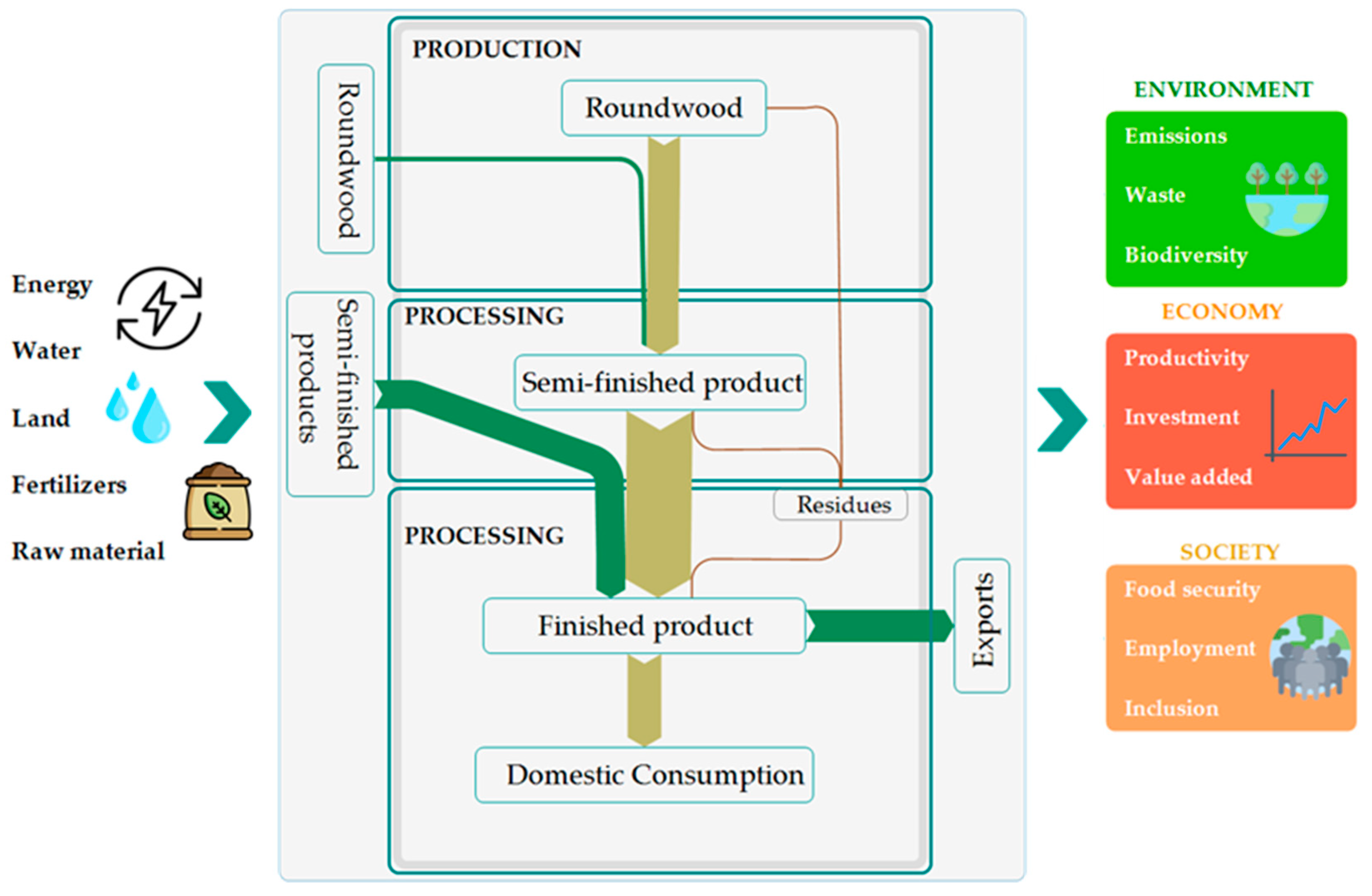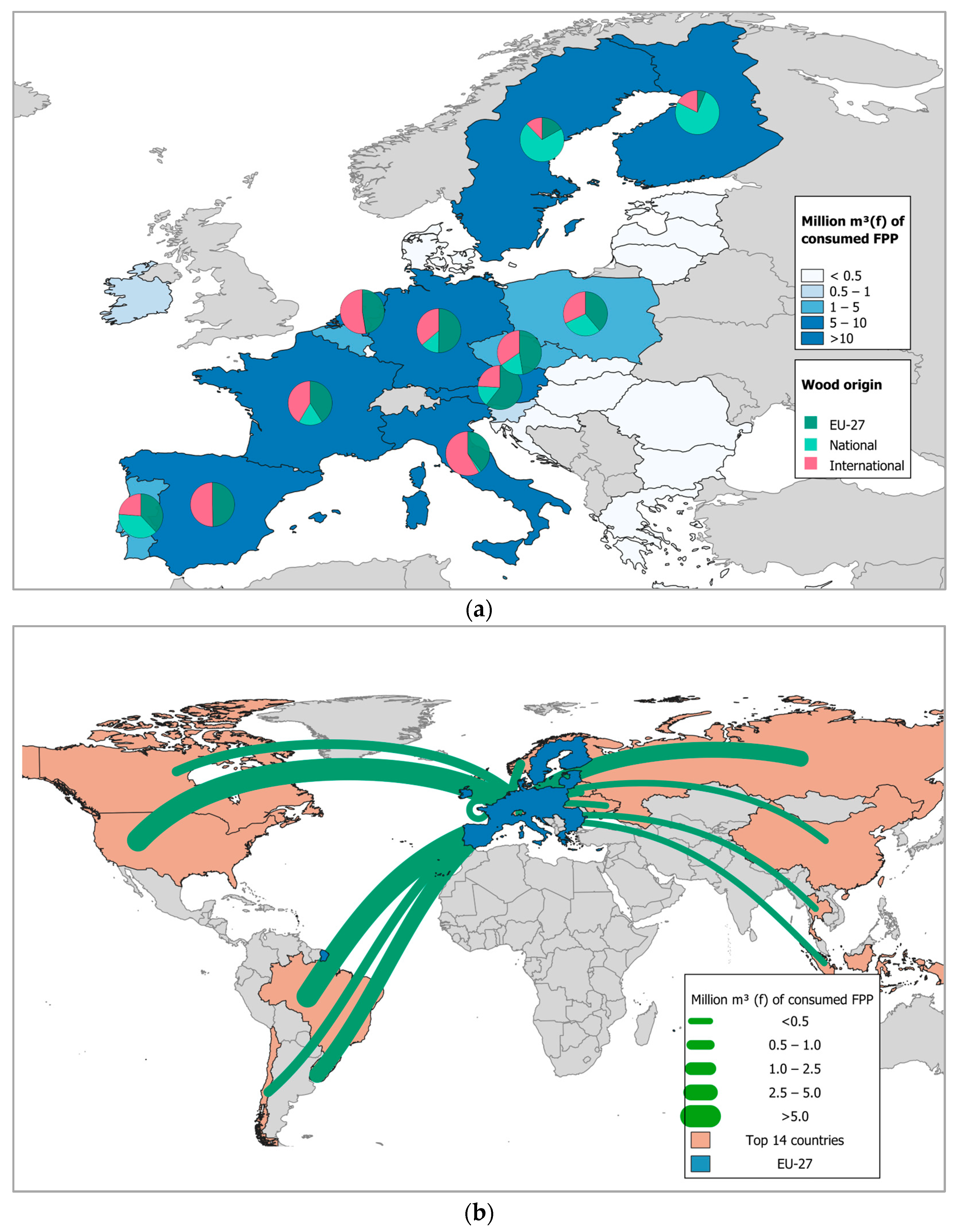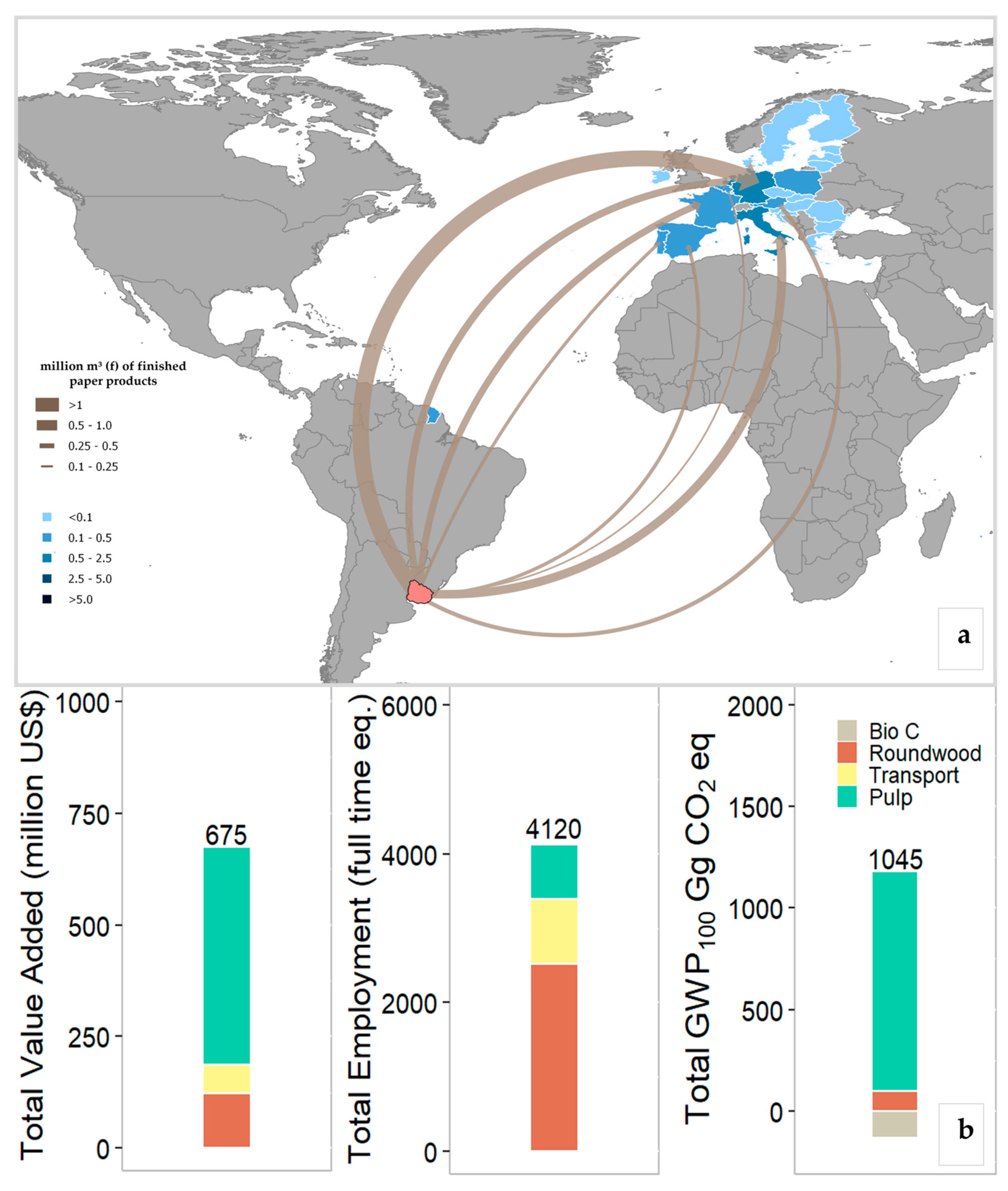Monitoring the Sustainability of the EU Biomass Supply: A Novel Hybrid Approach Combining Tracing and Selected Sustainability Impacts
Abstract
:1. Introduction
2. Materials and Methods
2.1. Tracing the Origin: Physical Accounting Model
2.2. Quantifying Sustainability Impacts: Material Flow–Life Cycle Assessment Approach
3. Results
3.1. Origin of Wood in Paper Consumption
3.2. Uruguay as a Case Study
4. Discussion
4.1. Footprints vs. Material Flow Approaches
4.2. Remarks on Data Gaps and Challenges
4.3. EU Wood Demand and Impacts in the Countries of Origin
5. Conclusions
Author Contributions
Funding
Data Availability Statement
Acknowledgments
Conflicts of Interest
References
- Sturm, V.; Banse, M. Transition paths towards a bio-based economy in Germany: A model-based analysis. Biomass Bioenergy 2021, 148, 106002. [Google Scholar] [CrossRef]
- Alviar, M.; García-Suaza, A.; Ramírez-Gómez, L.; Villegas-Velásquez, S. Measuring the Contribution of the Bioeconomy: The Case of Colombia and Antioquia. Sustainability 2021, 13, 2353. [Google Scholar] [CrossRef]
- Calicioglu, Ö.; Bogdanski, A. Linking the bioeconomy to the 2030 sustainable development agenda: Can SDG indicators be used to monitor progress towards a sustainable bioeconomy? New Biotechnol. 2021, 61, 40–49. [Google Scholar] [CrossRef] [PubMed]
- Bringezu, S.; Distelkamp, M.; Lutz, C.; Wimmer, F.; Schaldach, R.; Hennenberg, K.J.; Böttcher, H.; Egenolf, V. Environmental and socioeconomic footprints of the German bioeconomy. Nat. Sustain. 2021, 4, 775–783. [Google Scholar] [CrossRef]
- Brizga, J.; Miceikienė, A.; Liobikienė, G. Environmental aspects of the implementation of bioeconomy in the Baltic Sea Region: An input-output approach. J. Clean. Prod. 2019, 240, 118238. [Google Scholar] [CrossRef]
- European Commission. A Sustainable Bioeconomy for Europe: Strengthening the Connection between Economy, Society and the Environment: Updated Bioeconomy Strategy; Publications Office of the European Union: Luxembourg, 2018. [Google Scholar] [CrossRef]
- Kastner, T.; Kastner, M.; Nonhebel, S. Tracing distant environmental impacts of agricultural products from a consumer perspective. Ecol. Econ. 2011, 70, 1032–1040. [Google Scholar] [CrossRef]
- Bruckner, M.; Häyhä, T.; Giljum, S.; Maus, V.; Fischer, G.; Tramberend, S.; Börner, J. Quantifying the global cropland footprint of the European Union’s non-food bioeconomy. Environ. Res. Lett. 2019, 14, 45011. [Google Scholar] [CrossRef]
- O’Brien, M.; Bringezu, S. European Timber Consumption: Developing a Method to Account for Timber Flows and the EU’s Global Forest Footprint. Ecol. Econ. 2018, 147, 322–332. [Google Scholar] [CrossRef]
- Kalt, G.; Kaufmann, L.; Kastner, T.; Krausmann, F. Tracing Austria’s biomass consumption to source countries: A product-level comparison between bioenergy, food and material. Ecol. Econ. 2021, 188, 107129. [Google Scholar] [CrossRef]
- O’Brien, M.; Schütz, H.; Bringezu, S. The land footprint of the EU bioeconomy: Monitoring tools, gaps and needs. Land Use Policy 2015, 47, 235–246. [Google Scholar] [CrossRef]
- Pendrill, F.; Persson, U.M.; Kastner, T. Deforestation Risk Embodied in Production and Consumption of Agricultural and Forestry Commodities 2005–2017. Available online: https://zenodo.org/records/4250532 (accessed on 19 July 2024).
- Marques, A.; Martins, I.S.; Kastner, T.; Plutzar, C.; Theurl, M.C.; Eisenmenger, N.; Huijbregts, M.A.J.; Wood, R.; Stadler, K.; Bruckner, M.; et al. Increasing impacts of land use on biodiversity and carbon sequestration driven by population and economic growth. Nat. Ecol. Evol. 2019, 3, 628–637. [Google Scholar] [CrossRef]
- Ortiz, A.M.D.; Outhwaite, C.L.; Dalin, C.; Newbold, T. A review of the interactions between biodiversity, agriculture, climate change, and international trade: Research and policy priorities. One Earth 2021, 4, 88–101. [Google Scholar] [CrossRef]
- Parish, E.S.; Herzberger, A.J.; Phifer, C.C.; Dale, V.H. Transatlantic wood pellet trade demonstrates telecoupled benefits. Ecol. Soc. 2018, 23, 28. [Google Scholar] [CrossRef]
- Chaudhary, A.; Kastner, T. Land use biodiversity impacts embodied in international food trade. Glob. Environ. Change 2016, 38, 195–204. [Google Scholar] [CrossRef]
- European Parliament and Council. EU 2023/of 31.05.2023 on the Making Available on the Union Market and the Export from the Union of Certain Commodities and Products Associated with Deforestation and Forest Degradation and Repealing Regulation (EU) No 995/2010; European Parliament and Council: Luxembourg, 2023. [Google Scholar]
- FAO. FAOSTAT Database. Available online: https://www.fao.org/faostat/en/#data (accessed on 19 July 2023).
- González-Gómez, M. Dynamics of pulp exports from South America to the European Union. Austrian J. For. Sci. 2019, 136, 313–330. [Google Scholar]
- Bösch, M.; Englert, H.; Weimar, H.; Dieter, M. Where das the wood comes from? A physical accounting model to trace the origin of wood-products. J. Clean. Prod. 2023, 384, 135604. [Google Scholar] [CrossRef]
- Pozo, P.; Gordillo, F.; Polcaro, S.; Gomez San Juan, M.; Schweinle, J. Monitorear la Sostenibilidad de la Bioeconomía—Piloto en Uruguay/Monitoring the Sustainability of the Bioeconomy—Pilot in Uruguay; FAO: Rome, Italy, 2023. [Google Scholar] [CrossRef]
- Schweinle, J.; Geng, N.; Iost, S.; Weimar, H.; Jochem, D. Monitoring Sustainability Effects of the Bioeconomy: A Material Flow Based Approach Using the Example of Softwood Lumber and Its Core Product Epal 1 Pallet. Sustainability 2020, 12, 2444. [Google Scholar] [CrossRef]
- UN Statistics Division. UN Comtrade. Available online: https://comtrade.un.org/ (accessed on 20 July 2022).
- Weimar, H. Der Holzfluss in der Bundesrepublik Deutschland 2009: Methode und Ergebnis der Modellierung des Stoffflusses von Holz. Available online: https://literatur.thuenen.de/digbib_extern/bitv/dn049777.pdf (accessed on 19 July 2024).
- DGF. Estadisticas Forestales 2021: Dirección General Forestal. Available online: https://www.gub.uy/ministerio-ganaderia-agricultura-pesca/datos-y-estadisticas/estadisticas/boletin-estadisticas-forestales-2021 (accessed on 1 June 2021).
- Schulte, M.; Hammar, T.; Stendahl, J.; Seleborg, M.; Hansson, P.-A. Time dynamic climate impacts of a eucalyptus pulp product: Life cycle assessment including biogenic carbon and substitution effects. GCB Bioenergy 2021, 13, 1831–1850. [Google Scholar] [CrossRef]
- Exante. Contribución del Complejo Forestal a la Economía Uruguaya. Available online: https://www.spf.com.uy/2020/12/15/la-contribucion-del-complejo-forestal-a-la-economia-uruguaya/ (accessed on 1 September 2023).
- Pendrill, F.; Persson, U.M.; Godar, J.; Kastner, T. Deforestation displaced: Trade in forest-risk commodities and the prospects for a global forest transition. Environ. Res. Lett. 2019, 14, 55003. [Google Scholar] [CrossRef]
- Priefer, C.; Jörissen, J.; Frör, O. Pathways to Shape the Bioeconomy. Resources 2017, 6, 10. [Google Scholar] [CrossRef]
- Arto, I.; Cazcarro, I.; Garmendia, E.; Ruiz, I.; Sanz, M.J. A new accounting framework for assessing forest footprint of nations. Ecol. Econ. 2022, 194, 107337. [Google Scholar] [CrossRef]
- Kastner, T.; Schaffartzik, A.; Eisenmenger, N.; Erb, K.-H.; Haberl, H.; Krausmann, F. Cropland area embodied in international trade: Contradictory results from different approaches. Ecol. Econ. 2014, 104, 140–144. [Google Scholar] [CrossRef]
- Kastner, T.; Erb, K.-H.; Nonhebel, S. International wood trade and forest change: A global analysis. Glob. Environ. Change 2011, 21, 947–956. [Google Scholar] [CrossRef]
- Zhang, Q.; Li, Y.; Yu, C.; Qi, J.; Yang, C.; Cheng, B.; Liang, S. Global timber harvest footprints of nations and virtual timber trade flows. J. Clean. Prod. 2020, 250, 119503. [Google Scholar] [CrossRef]
- Uruguay XXI. Sector Forestal en Uruguay: Promoción de Inversiones, Exportaciones e Imagen País. Available online: https://www.uruguayxxi.gub.uy/es/centro-informacion/ (accessed on 1 May 2021).
- Hoekstra, J.M.; Boucher, T.M.; Ricketts, T.H.; Roberts, C. Confronting a biome crisis: Global disparities of habitat loss and protection. Ecol. Lett. 2005, 8, 23–29. [Google Scholar] [CrossRef]
- Brazeiro, A.; Achkar, M.; Toranza, C.; Bartesaghi, L. Agricultural expansion in Uruguayan grasslands and priority areas for vertebrate and woody plant conservation. Ecol. Soc. 2020, 25, 15. [Google Scholar] [CrossRef]
- DGF. Cartografía Nacional Forestal 2021: Dirección General Forestal. Available online: https://descargas.mgap.gub.uy/Documentos%20compartidos/publicaci%C3%B3n_Cartograf%C3%ADa_forestal_nacional_2021.pdf (accessed on 12 December 2023).
- Pozo, P.; Säumel, I. How to Bloom the Green Desert: Eucalyptus Plantations and Native Forests in Uruguay beyond Black and White Perspectives. Forests 2018, 9, 614. [Google Scholar] [CrossRef]
- zu Ermgassen, E.K.H.J.; Ayre, B.; Godar, J.; Bastos Lima, M.G.; Bauch, S.; Garrett, R.; Green, J.; Lathuillière, M.J.; Löfgren, P.; MacFarquhar, C.; et al. Using supply chain data to monitor zero deforestation commitments: An assessment of progress in the Brazilian soy sector. Environ. Res. Lett. 2020, 15, 35003. [Google Scholar] [CrossRef]
- zu Ermgassen, E.K.H.J.; Godar, J.; Lathuillière, M.J.; Löfgren, P.; Gardner, T.; Vasconcelos, A.; Meyfroidt, P. The origin, supply chain, and deforestation risk of Brazil’s beef exports. Proc. Natl. Acad. Sci. USA 2020, 117, 31770–31779. [Google Scholar] [CrossRef]
- Vasconcelos, A. Uncovering the Deforestation and Climate Risks of Chinese and EU Soy and Beef Imports from South America. Available online: https://www.wilsoncenter.org/sites/default/files/media/uploads/documents/Uncovering%20the%20Deforestation%20and%20Climate%20Risks.pdf (accessed on 7 July 2024).
- Ferraz, S.F.d.B.; Rodrigues, C.B.; Garcia, L.G.; Alvares, C.A.; Lima, W.d.P. Effects of Eucalyptus plantations on streamflow in Brazil: Moving beyond the water use debate. For. Ecol. Manag. 2019, 453, 117571. [Google Scholar] [CrossRef]




Disclaimer/Publisher’s Note: The statements, opinions and data contained in all publications are solely those of the individual author(s) and contributor(s) and not of MDPI and/or the editor(s). MDPI and/or the editor(s) disclaim responsibility for any injury to people or property resulting from any ideas, methods, instructions or products referred to in the content. |
© 2024 by the authors. Licensee MDPI, Basel, Switzerland. This article is an open access article distributed under the terms and conditions of the Creative Commons Attribution (CC BY) license (https://creativecommons.org/licenses/by/4.0/).
Share and Cite
Pozo, P.; Bösch, M.; Schweinle, J. Monitoring the Sustainability of the EU Biomass Supply: A Novel Hybrid Approach Combining Tracing and Selected Sustainability Impacts. Land 2024, 13, 1366. https://doi.org/10.3390/land13091366
Pozo P, Bösch M, Schweinle J. Monitoring the Sustainability of the EU Biomass Supply: A Novel Hybrid Approach Combining Tracing and Selected Sustainability Impacts. Land. 2024; 13(9):1366. https://doi.org/10.3390/land13091366
Chicago/Turabian StylePozo, Paola, Matthias Bösch, and Jörg Schweinle. 2024. "Monitoring the Sustainability of the EU Biomass Supply: A Novel Hybrid Approach Combining Tracing and Selected Sustainability Impacts" Land 13, no. 9: 1366. https://doi.org/10.3390/land13091366




